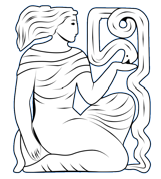Gavin Wilk
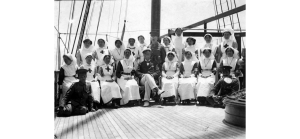
[Fig 1] Nurses and Orderlies with Sir Thomas Lipton (seated at centre) on board the Erin bound for Serbia, 11 May 1915. The Mitchell Library, Sir Thomas Lipton Collection, Record 387. With kind permission from ©CSG CIC Glasgow Museums and Libraries Collection: The Mitchell Library, Special Collections.
On the morning of Sunday 26 September 1914, a group of ten doctors, twenty nurses and sixty two orderlies gathered at Waterloo Station in London.[1] Here they were joined by Constance Edwina Lewis, the Duchess of Westminster, who over one week earlier, had been approved by the War Office to ‘serve with the Red Cross in the field.’[2] Under Lewis’ patronage, this medical staff intended on traveling to France along with ‘a large quantity of … material’ to set up a hospital. After publicly parading to the station, they boarded the train bound for Southampton.[3] Awaiting their arrival over 130 kilometres at the southern English port was famous sportsman and tea magnate Sir Thomas Lipton, who had offered to superintend their ‘arrangements of transport’. Lipton’s steam yacht, Erin, which had only a few weeks earlier returned from New York, was now generously placed by him at the ‘at the disposal of the hospital.’[4]
The rapid war developments during the summer meant that as in the words of Ian Kershaw, ‘After August 1914 nothing could be the same again.’[5] In the western theatre, the Battle of the Marne fought in September had resulted in defensive and deadly trench warfare. In the east, a different environment existed, and a much more fluid military dynamic was required.[6] However, the speed at which the war spread, in addition to the deadly technological weaponry advancements of the time, meant as Jessica Meyer has noted, ‘voluntary medical aid organizations in Britain were ill-prepared’.[7] This in turn created a space for individuals such as the Duchess of Westminster and Sir Thomas Lipton to assist. This article, which forms the early stage of a larger research project, will focus specifically on Lipton’s benevolence through to mid-1915. His actions both in public and private, and especially his interactions with and assistance to the nurses involved with British and American Red Cross efforts, offer a glimpse into a generosity which was outspoken but also very personal.
Born and raised in Glasgow, Scotland, Lipton had at an early age embraced the entrepreneurial spirit. After initially being introduced to the grocery business by his father, a shop owner, he complemented his early education in industry by working for a stationer and a shirtmaker, and also with a steamship line. In 1865 Lipton travelled to the US, where he toiled in the tobacco fields of a Virginia plantation and as a bookkeeper at a South Carolina rice field. The most impactful experience however was when he worked in a large grocery store in New York City. After returning home at the age of twenty, Lipton used his savings to fund the opening of a grocery shop in Glasgow. His penchant for publicity and advertising soon helped expand his business to Wales and England, and by the 1880s, he reached even further afield by purchasing a meatpacking factory in Chicago and tea plantations in Ceylon.[8] The latter transaction catapulted his name internationally as Lipton tea would quickly become a worldwide brand and especially popular in the US. Here, the tea was noted as being ‘absolutely pure and the finest the world can produce.’[9] Lipton’s celebrity status grew even more so in the American public eye when he entered the world of yacht racing. He would also on occasion visit the country on his steam yacht, the Erin.[10] A philanthropic mindset developed within him and he supported a number of British local charitable schemes.[11] Subsequently, with the outbreak of the First World War, Lipton merged his philanthropic goodwill, publicity savviness, and maritime connections to assist the Allied cause.
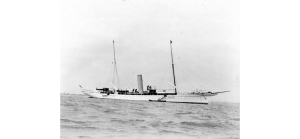
[Fig 2] Erin, July 1908. The Mitchell Library, Sir Thomas Lipton Collection, Record 1558. With kind permission from ©CSG CIC Glasgow Museums and Libraries Collection: The Mitchell Library, Special Collections.
According to Peter Grant, ‘The First World War saw the greatest act of volunteering ever in Britain.’[12] As the following pages will show, Lipton’s work not only helped the British military, but like so many philanthropists and organisations during the time went further afield to ‘aid … other causes’.[13] Although this philanthropy was vital and was recorded in primary sources, scholarship is now just starting to reveal the depth of the British efforts.[14] Furthermore, the revelation of Lipton’s actions towards American medical actors in Europe during the time, adds another layer to the transatlantic charitable historical narrative which has largely been dominated by the efforts of another industrialist. John D. Rockefeller’s foundation, in the words of Helke Rausch, ‘was present at the creation of this rising American humanitarian cloud’ during the early years of the war.[15] As will be seen, Lipton’s willingness to enter combat zones and connect and assist medical volunteers subsequently brought his own humanitarian efforts to another, distinctive level.
When Lipton greeted the medical staff who had arrived after their journey from London, he brought them to the Erin, where they prepared for the Channel crossing. Upon finishing dinner any feeling of relaxation would have evaporated, as Lipton escorted them to an adjacent ‘Red Cross ship which had just arrived with 600 wounded on’. It appears the nurses were brought to take in the scene in order to prepare for what was ahead. In a letter written a few hours later by Welsh nurse Betty Broadbent to a friend, the devastating scenes of the injured soldiers were staggering: ‘They are very badly wounded, some with eyes blown out. Boys of 18 with arms off, and some legs off.’ For Broadbent, this was ‘too sad to realize.’ She soberly concluded, ‘I am afraid we are in for heavy work.’[16]
The Erin’s subsequent voyage was delayed twenty four hours due to the temporary suspension of British shipping in the English Channel, owing to an ‘unconfirmed report’ of German submarines in the vicinity. Once the restrictions were lifted, the vessel ‘piled high with bales and cases containing lint, cotton … and other supplies’ made its way safely to the French port of Le Havre.[17] The medical staff subsequently travelled to Paris and then on to Le Touquet-Paris-Plage, where Red Cross Hospital No. 1 was set up. This establishment was described some months later as ‘magnificently-equipped … where cases from the firing line can be quickly and efficiently dealt with.’[18] For Lipton, his philanthropic endeavour had proven successful. Although his comment to an International News Correspondent that the ‘The [German] Kaiser wants back the cups he presented to my Shamrocks [racing yachts]’ over the years was likely a sarcastic quip, he had firmly established the depths of his support for the allied cause. Publicly, this was reinforced when a photo of himself and the twenty nurses along with the Duchess of Westminster on board the Erin soon appeared in newspapers throughout the world.[19]
During this time, attention in both British and American circles was also focussed on the plight of Serbia. In Autumn 1914, an American Red Cross unit under the guidance of nurse Mary Gladwin and doctor Edward Ryan arrived in Belgrade, while a British Red Cross unit under the direction of Lady Louise Paget, whose husband, Ralph, was the British Commissioner for Serbia, was based at a hospital in Nish. [20] Fighting in Serbia was fierce and eyewitness accounts detailed constant shelling. The back-and-forth nature of the fighting meant that both the Serbian and Austro-Hungarian forces were in and out of civilian areas. This contributed to an outbreak of typhus, which quickly ravaged population centres.[21]
Assistance for Serbia became an urgent matter, and in the new year Lipton in turn ‘generously lent’ the Erinto the Joint Committee of the British Red Cross Society and the Order of St. John ‘for the relief of wounded soldiers of our Allies in Serbia and Montenegro.’ [22] Lipton promised to ‘defray the whole cost of shipping’, and in mid-January, the Erin once again left Southampton, but this time it was bound for Salonica, Greece.[23] Ernest Nathaniel Benett, a commissioner in the British Red Cross, who had deep political and journalistic ties was selected to lead the mission, which included the delivery of supplies as well as the transfer of British nurses and doctors into Serbia.[24] Lipton, along with medical staff and several more British Red Cross nurses eventually boarded the Erin a few days later at Marseilles.[25]
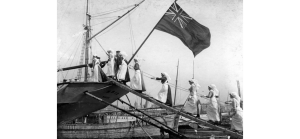
[Fig 3] Nurses embarking at Marseilles for Serbia. The Mitchell Library, Sir Thomas Lipton Collection, Record 342. With kind permission from ©CSG CIC Glasgow Museums and Libraries Collection: The Mitchell Library, Special Collections.
Keenly aware of the ‘strenuous’ work awaiting those on board, Lipton ‘spared nothing to give the hospital party all the pleasure possible on the voyage’.[26] Typhoid vaccinations were administered, and a photo showing a nurse on board receiving the inoculation was published a few days later in the press.[27] On 3 February, the Erin arrived in Brindisi, Italy and while waiting British Red Cross workers assisted with unloading some of the material from the ship.[28] After landing in Piraeus, Greece, an enthusiastic King Constantine I, along with the Crown Prince, boarded the vessel. The King chatted with Lipton and others, and thanked them for their efforts. While departing from the Greek harbour, sailors aboard naval ships ‘cheered heartily’ for the volunteers on the Erin whose efforts were described in the press as a ‘mission of mercy’.[29]
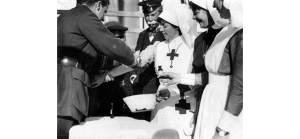
[Fig 4] Inoculating nurses against typhoid. The Mitchell Library, Sir Thomas Lipton Collection, Record 345. With kind permission from ©CSG CIC Glasgow Museums and Libraries Collection: The Mitchell Library, Special Collections.
When the Erin arrived in Salonica on 12 February, the remaining supplies were taken off the ship and loaded onto various ‘railway vans’.[30] Bennett along with the doctors and nurses headed out to Vrnjačka Banja, where they set up a Red Cross Mission. [31] Lipton, intent on assessing the current conditions of the country, conducted his own personal tour. While in Belgrade and accompanied ‘with several newspapermen’ he visited the American hospital. Mary Gladwin, who was leading the unit of nurses there recalled serving a cup of tea to Lipton, a formidable challenge considering that ‘The only means of boiling water was over a defective Bunsen burner’.[32] Although she was embarrassed by the rudimentary service, her efforts did impress Lipton. Upon returning to the hospital one day later with Lady Paget, Lipton commented that Gladwin had given him ‘the best cup of tea I ever drank.’ Gladwin was taken aback considering the comment was ‘from a tea- merchant and Englishman.’ Before Lipton’s departure, he sent the hospital ‘a big hamper of tea’. And for Gladwin, he personally gave her ‘a small box containing his gold and green yacht emblem’, which he noted was ‘In memory of that first cup of tea you gave me.’[33]
These light hearted moments would have provided a welcome distraction from what Gladwin described as the ‘devastation’ that had spread.[34] When Lipton was in Nish, he received a report that 300 typhus patients had recently died.[35] Over the following weeks, doctors and nurses would also become sick, and in some of these cases, the impacts were similarly deadly.[36] To add to the despair, military activities continued. Indeed, while Lipton was at the crown prince’s palace in Belgrade, he witnessed a shell land ‘100 yards away’ which destroyed a building and killed two people. Later, while driving to a dinner engagement, another shell exploded twenty yards from him and took the life of one of his Serbian hosts.[37]
Lipton made his way to Paris at the end of March to attend a conference held by the French government. This event, set up to look at the question of Serbian assistance, included representatives from British, French and American aid societies. Among the dignitaries present was Ernest Bicknell, the national director of the American Red Cross and representative of the Rockefeller foundation. It was agreed by all at the conference that Britain, the US and France would be responsible for specific geographical zones in Serbia. In speaking to the press, Lipton noted that ‘Far more effective work could be done in this way.’[38]
Efforts to raise funds continued and in April, a pamphlet co-authored by Lipton entitled, ‘The Terrible Truth About Serbia’ was published. This publication which was on sale for a penny, included a subscription page in the back where individuals could tear out and post any amount to the British Red Cross Society in Pall Mall, London.[39] In recounting his individual experiences, Lipton noted how ‘There is not a tithe of the hospital accommodation necessary’ in Serbia. There were ‘no [locally] trained nurses’ and ‘Its supply of doctors is nearly exhausted.’ The fact that new clothing could not be provided to individuals was disastrous, especially considering that ‘hundreds of thousands … are wearing garments that should be burned.’ Lipton concluded that ‘Serbia is quite unable to cope with the disease’.[40]
The response proved robust, and by the middle of April, Lipton declared that ‘Considerable sums of money have already been sent to the Red Cross Society’. Plans were once again put into place to send the Erin to Serbia.[41] In early May, it departed from Southampton with medical supplies and ‘a number of nurses’. Lipton once again boarded the Erin in Marseilles.[42] By this time, internal government reports began to surface that the typhus epidemic had been contained. On 4 May Sir Ralph Paget, the British Commissioner for Serbia noted to a colleague that ‘as far as the Railway line [from Salonica] goes the infection is sufficiently in hand.’[43] After arriving, Lipton also saw firsthand how the epidemic had subsided. There were no restrictions on his travel and a number of the typhus hospitals closed their doors ‘for a lack of patients’.[44] Although he was officially honoured by the Serbian government for his philanthropic efforts, Lipton would deflect any credit, describing a few weeks later that ‘the sanitation reforms enforced by Americans’ were ‘rapidly making typhus a thing of the past.’[45] Lipton’s praise for the American efforts, set during a period when the American public and government was assessing its next steps after the German sinking of the Lusitania which claimed the lives of over 100 US citizens, does raise the possibility that there was some unofficial statesmanship in the words implying the value of ‘American intervention’.[46] His private benevolent actions, however, continued to make the most impact, especially when it came to assisting American nurses with their Serbian departures.[47]
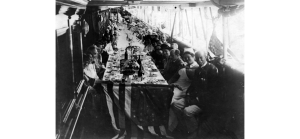
[Fig 5] Luncheon to American doctors and nurses on board the Erin at Salonica. The Mitchell Library, Sir Thomas Lipton Collection, Record 388. With kind permission from ©CSG CIC Glasgow Museums and Libraries Collection: The Mitchell Library, Special Collections.
When the Erin left Salonica in mid-June, it included a number of American nurses on board, fifteen of whom would eventually be taken to Marseilles. According to the New York Times, ‘more than half’ of these fifteen nurses who disembarked in the southern French city on 28 June were recovering from typhus.[48] Included was Helen Kerrigan, who had boarded the yacht while still recovering from a bout of typhus. She would remain in Europe for the remainder of the war.[49] Agnes Gardner who had gone ashore from the yacht in Naples days earlier would depart for the US aboard an Italian steamship. She would eventually write an article about her experiences in Serbia which appeared a few months later in the American Journal of Nursing.[50] Mary Keller who volunteered ‘to help the sick and suffering’ when the yacht called into Malta, would eventually return to Long Island, New York. She stayed in touch with Lipton, and in early 1916, received a letter from him with some updates. Noting that the Erin was likely back in Malta, he revealed further that after a period of illness, he was feeling better and ‘getting back to my old form’. Looking towards the future, he hoped ‘to arrive in New York’ soon. Lipton further affirmed to Keller how ‘it will be a great pleasure to me to see you once more … and meet all your friends – the nurses.’[51]
In the span of ten months, Lipton’s philanthropic efforts had impacted thousands of people across Europe. The three journeys the Erin had made to the Continent ensured the delivery of urgent medical supplies and the transport of highly qualified medical volunteers. On board, preparations could be made, relaxation could occur, and recovery could take place. His public appeals, aided by a keen promotional awareness, also resulted in a substantial amount of funds being raised. But above all, the bonds and friendship that Lipton created with the medical volunteers, and especially the nurses, proved the most powerful and enduring legacies of his generosity.
[1] Anonymous, ‘Duchess of Westminster’s Hospital’, Western Times (Exeter), 3 October 1914, 4. Available at www.britishnewspaperarchive.co.uk [Accessed 2 June 2024].
[2] Anonymous, ‘Duchess Who is to Serve With the Red Cross in the Field’, Leeds Mercury, 15 September 1914, 8. Available at www.britishnewspaperarchive.co.uk [Accessed 2 June 2024].
[3] Anonymous, ‘Duchess of Westminster’s Hospital’, Western Times (Exeter), 3 October 1914, 4. Available at www.britishnewspaperarchive.co.uk [Accessed 2 June 2024].
[4] Ibid.; Anonymous, ‘Duchess’s War Hospital’, Globe, 30 September 1914, 5. Available at www.britishnewspaperarchive.co.uk [Accessed 2 June 2024]. For more information about the return of the Erin, see Anonymous, ‘The Erin’, Western Times, 8 September 1914, 5. Available at www.britishnewspaperarchive.co.uk [Accessed 2 June 2024]. Lipton arrived after accompanying his racing vessel, Shamrock, across the Atlantic to an America’s Cup sailing race which had subsequently been postponed due to the war
[5] Ian Kershaw, To Hell and Back: Europe 1914-1949 (London: Penguin Books, 2016), 44.
[6] Kershaw, To Hell and Back, 47-52.
[7] Jessica Meyer, ‘Neutral Caregivers or Military Support? The British Red Cross, the Friends’ Ambulance Unit, and the Problems of Voluntary Medical Aid in Wartime’, War & Society, 34/2 (2015), 110.
[8] Herbert Grimsditch and Gareth Shaw, ‘Lipton, Sir Thomas Johnstone, baronet (1850-1931), grocer and yachtsman’, Oxford Dictionary of National Biography (Oxford: Oxford University Press, 2004). Available at https://www.oxforddnb.com/ [Accessed 10 October 2024].
[9] Anonymous, ‘Pure Tea’, Boston Globe, 22 Mar 1896, 31. Available at www.newspapers.com [Accessed 13 October 2024].
[10] For an example, see Anonymous, ‘With the Yachts in the Parade’, San Francisco Chronicle, 30 September 1899, 2. Available at www.newspapers.com [Accessed 13 October 2024].
[11] Grimsditch and Shaw, ‘Lipton, Sir Thomas Johnstone’.
[12] Peter Grant, Mobilizing Charity: Philanthropy and Voluntary Action in the First World War (New York: Routledge, 2014), 2.
[13] Grant, Mobilizing Charity, 2.
[14] Grant, Mobilizing Charity, 2-7.
[15] Helke Rausch, ‘The Birth of Transnational U.S. Philanthropy from the Spirit of War’, The Journal of the Gilded Age and Progressive Era, 17/4 (2018), 653.
[16] Anonymous, ‘Denbigh Nurse Amongst the Wounded Soldiers’, Denbighshire Free Press, 3 October 1914, 3. Available at www.britishnewspaperarchive.co.uk [Accessed 8 June 2024].
[17] International News Service staff correspondent, ‘Lipton Yacht Safe in French Harbor’, Allentown Democrat (Pennsylvania, USA), 2 October 1914, 1. Available at www.newspapers.com [Accessed 13 August 2024].
[18] Anonymous, ‘Denbigh Nurse’, 3.. Anonymous, ‘A Fine Work: The Duchess of Westminster’s War Hospital at Le Touquet’, The Tatler, 16 December 1914, 13. Available at www.britishnewspaperarchive.co.uk[Accessed 8 June 2024].
[19] Anonymous, ‘Yacht Racer Escorting Nurses to War Zone’, Detroit Free Press, 19 October 1914, 7. Available at www.newspapers.com [Accessed 30 August 2024]. Anonymous, ‘The Week’s Pictures of War Incidents’, Reynolds’s Newspaper, 11 October 1914, 3. Available at www.britishnewspaperarchive.co.uk[Accessed 30 August 2024].
[20] Gavin Wilk, ‘‘Never shall I forget the awful sights’: The Nursing Career of Helen L. Kerrigan (c.1876 – 1950)’, The UK Association for the History of Nursing (UKAHN) Bulletin 11/1 (2023). Available at https://bulletin.ukahn.org/vol-11-1-2023/ [Accessed 30 August 2024]. Anonymous, ‘Red Cross for Serbia’, 31 October 1914, 2. Available at www.britishnewspaperarchive.co.uk [Accessed 15 August 2024].
[21] Lavinia Dock, History of American Red Cross Nursing (New York: MacMillan, 1922), 176-8. Available at http://resource.nlm.nih.gov/14310740R [accessed 1 September 2023].
[22] Anonymous, ‘Red Cross for Serbia’, Northern Whig, 8 January 1915, 7. Available at www.britishnewspaperarchive.co.uk [Accessed 30 August 2024].
[23] Anonymous, ‘Sir Thomas Lipton’s Hospital Yacht’, The Scotsman, 14 January 1915, 7. Available at www.britishnewspaperarchive.co.uk [Accessed 30 August 2024]. Anonymous, ‘Erin’s Good Errand’, The Hamilton Spectator (Canada), 18 January 1915, 11. Available at www.newspapers.com [Accessed 30 August 2024].
[24] Ibid.; For more information on Bennett, see Roger T. Stearn, ‘Bennett, Sir Ernest Nathaniel’, Oxford Dictionary of National Biography (2013). Available at https://doi.org/10.1093/ref:odnb/58683 [Accessed 30 August 2024].
[25] Anonymous, ‘British Assistance for Serbia’, Daily Malta Chronicle and Garrison Gazette, 27 January 1915, 10. Available at www.britishnewspaperarchive.co.uk [Accessed 30 August 2024]. Anonymous, ‘British Nurses for Serbia’, 2 February 1915, 4. Available at www.newspapers.com [Accessed 30 August 2024].
[26] Anonymous, ‘Help asked and given’, The Queen, 20 February 1915, 50. Available at www.britishnewspaperarchive.co.uk [Accessed 30 August 2024].
[27] Anonymous, ‘Voyage of the Erin’, Dundee Evening Telegraph, 17 February 1915, 4. Available at www.britishnewspaperarchive.co.uk [Accessed 13 June 2024].
[28] Anonymous, ‘British Red Cross Mission for Serbia’, The Scotsman, 4 February 1915, 5. Available at www.britishnewspaperarchive.co.uk [Accessed 13 June 2024].
[29] Anonymous, ‘King of Greece Pays a Visit to the Erin’, Daily News (London), 10 February 1915, 2. Available at www.britishnewspaperarchive.co.uk [Accessed 13 June 2024].
[30] Anonymous, ‘Lipton at Salonika’, The Republican (Springfield, Massachusetts, USA), 12 February 1915, 1. Available at www.newspapers.com [Accessed 8 August 2024]. James Berry, Frances Berry and Walter Blease, The Story of a Red Cross Unit in Serbia (London: J. & A. Churchill, 1916), 20. Available at https://archive.org/details/storyofredcrossu00berruoft [Accessed 8 August 2024).
[31] Berry, Berry and Blease, The Story of a Red Cross Unit in Serbia, 24-37.
[32] Mary E. Gladwin Unpublished Memoir, ‘The Red Crosser’, 186, Ohio Memory, World War I in Ohio Collection. Available at https://www.ohiomemory.org/digital/collection/p16007coll51/id/3516/rec/5 [Accessed 1 September 2024).
[33] Mary E. Gladwin Unpublished Memoir, ‘The Red Crosser’, 188, Ohio Memory, World War I in Ohio Collection. Available at https://www.ohiomemory.org/digital/collection/p16007coll51/id/3518/rec/5 [Accessed 1 September 2024].
[34] Gladwin, ‘The Red Crosser’, 189.
[35] Anonymous, ‘Stricken Serbia’, The Ramsbottom Observer, 2 April 1915, 7. Available at www.britishnewspaperarchive.co.uk [Accessed 13 June 2024].
[36] Wilk, ‘‘Never shall I forget the awful sights’’..
[37] Anonymous, ‘Shell Just Misses Lipton’, Danville Register and Bee (Virginia, USA), 28 February 1915, 14. Available at www.newspapers.com [Accessed 13 June 2024].
[38] Anonymous, ‘For Relief of Servia’, The Republican (Springfield, Massachusetts, USA),
31 March 1915, 16. Available at www.newspapers.com [Accessed 13 June 2024].
[39] Thomas Lipton, The Terrible Truth about Serbia (London: British Red Cross Society, 1915). Available at https://digitalcollections.ucalgary.ca/asset-management/2R3BF1FUMAG0A (Military History Collection, Libraries and Cultural Resources Digital Collections, University of Calgary) [Accessed 1 September 2024].
[40] Lipton, The Terrible Truth, 11.
[41] Thomas Lipton, ‘The Miseries of Servia’, Manchester Guardian, 15 April 1915, 12. Available at www.newspapers.com [Accessed 13 June 2024].
[42] Anonymous, ‘Sir Thomas Lipton is Benefactor to Serbia’, Daily Malta Chronicle and Garrison Gazette, 13 May 1915, 5. Available at www.britishnewspaperarchive.co.uk [Accessed 13 June 2024].
[43] National Archives, FO 372/711, Foreign Office Papers, General Correspondence, Serbia, Paget to Nicolson, 4 May 1915.
[44] Anonymous, ‘Praises U.S. Nurses’, Washington Post, 18 July 1915, 12. Available at www.newspapers.com [Accessed 1 September 2024].
[45] Anonymous, ‘Serbs Honor Sir Thomas Lipton’, Chicago Tribune, 30 May 1915, 2. Available at www.newspapers.com [Accessed 1 September 2024]. Anonymous, ‘Praises U.S. Nurses’, Washington Post, 18 July 1915, 12. Available at www.newspapers.com [Accessed 1 September 2024].
[46] For an example of a British opinion towards American war possibilities, see Anonymous, ‘If America Came into the War’, Nottingham Evening Post, 2 June 1915, 1. Available at www.newspapers.com[Accessed 1 September 2024].
[47] Anonymous, ‘Lipton Rescues Nurses’, New York Times, 30 June 1915, 2. Available at www.proquest.com [Accessed 8 September 2024].
[48] Anonymous, ‘Lipton Rescues Nurses’, 2..
[49] Wilk, ‘‘Never shall I forget the awful sights’’..
[50] Agnes Gardner, ‘American Red Cross Work in Serbia’, The American Journal of Nursing, 16/1 (1915), 36-40, available at https://doi.org/10.2307/3406151 [Accessed 1 September 2024].
[51] Hicksville Public Library, The Keller Family Collection, 1911-75, Thomas Lipton to Mary F. Keller, 27 January 1916.
